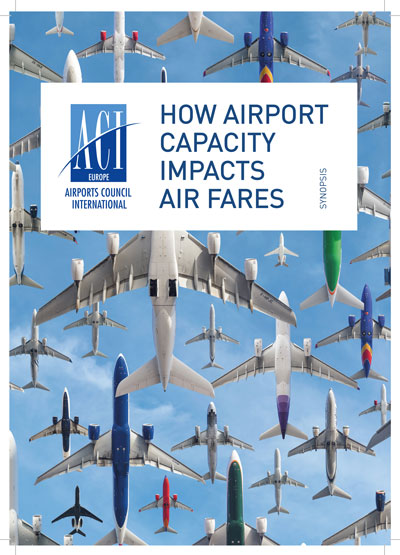As warnings of the looming airport capacity crunch become louder in Europe, a new study reveals that its implications go beyond airport operations and actually end up costing consumers. Report by Inês Rebelo, edited by Elliot Bailey.
Last year, European airports welcomed over 2 billion passengers for the very first time, with passenger traffic growth in Europe averaging 5.1% over the full year. While this strong trend of increasing air traffic is good news for airports and the economies of the cities and regions they serve, the need for more airport capacity is becoming more and more apparent. All the more so, when you consider the implications of a lack of airport capacity – connectivity, efficiency, environment, punctuality, operational flexibility – all of these things start to suffer.

A new research study by SEO Amsterdam Economics & Cranfield University, entitled The Impact of Airport Capacity Constraints on Air Fares, finds that European consumers are paying €2.1 billion a year in additional air fares, due to capacity constraints at airports. ACI EUROPE has released a 20-page synopsis of the study’s key findings, entitled How Airport Capacity Impacts Air Fares.
A new research study by SEO Amsterdam Economics & Cranfield University has uncovered another implication – higher ticket prices for air travellers. They conducted a thorough investigation into air fares at congested airports – while also checking airport charges levels at the airports in question. The comprehensive study entitled The Impact of Airport Capacity Constraints on Air Fares finds that European consumers are paying €2.1 billion a year in additional air fares, due to capacity constraints at airports.
How so? Scarce capacity ultimately means reaching the limit of the number of aircraft that can arrive at or depart from an airport – particularly at the busiest times of the day or year. And while economic regulation of larger air-ports keeps airport charges low – and even below actual airport costs in some cases, it does not suppress demand.
With passenger demand to fly at peak times continuing to rise at congested airports, but the supply of aircraft & air services remaining constant, prices go up – meaning that passengers have to pay higher air fares to airlines if they wish to fly to/from these airports. And with no spare airport capacity, market access is blocked – effectively prevent-ing more airlines from entering and competing down air fares. Incumbent airlines reap the benefit, by being able to charge more to fly – this additional amount is known as a ‘scarcity rent’.
The study finds that airlines can and do increase their fares as a reaction to higher demand. These findings are relevant to the European Commission’s recently launched evaluation of the EU Airport Charges Directive, as they prove that lower airport charges through more regulation would not result in lower air fares for consumers and that any related cost-savings would go directly to airlines’ profit margins instead.
At its New Year Reception at the European Parliament in January – in the presence of representatives from several major airlines – ACI EUROPE released a 20-page synopsis of the study’s key findings, entitled How
Airport Capacity Impacts Air Fares.
Announcing the publication, Augustin de Romanet, President of ACI EUROPE & Chairman and CEO of Aéroports de Paris S.A. – Groupe ADP, said “This new study spells it out very clearly. Incumbent airlines are collecting scarcity rents at capacity constrained airports – which of course undermines their incentive to support capacity expansion and also helps explain why they so fiercely oppose increases in airport charges. By 2035, passengers will be paying €6.5 billion a year in higher fares, specifically due to a lack of airport capacity.”
To tackle this problem, one solution is to increase airport capacity by incentivising investment in airport infrastructure. Airports need to expand to align their capacity with increasing demand. More airport capacity will allow for more airline capacity, for more competitors in the market, with a cascade of other positive effects too (operational flexibility, more efficiency and better punctuality).
EUROCONTROL estimates the airport capacity crunch will see 12% of demand unaccommodated by 2035, meaning that 237 million passengers will be unable to travel. That’s only 18 years away – not a long time in the world of infrastructure planning.







